
Design should make wind less of a factor at new Buffalo Bills stadium
The thousands of metal panels being erected serve as a wind screen and are unique in some way, with different size perforations on them to help confuse the wind.
The façade of the Buffalo Bills new stadium came into focus this week when team owner Terry Pegula talked about how wind will become less of a factor for future home games during Tuesday’s episode of “Hard Knocks.”
While touring the new stadium alongside star quarterback Josh Allen, Pegula brought up the science behind the architecturally focused perforated metal panels being put up right now on the building’s exterior and how they will help with wind confusion, keeping intense breezes from entering the stadium.
“He understands that it is not just glass on the side of a building,” said Frank Cravotta, senior vice president of creative and stadium design for the Bills. “It’s that there’s team performance concerns, there’s fan comfort concerns, followed by the opportunity to tell a great story from an aesthetic perspective.”
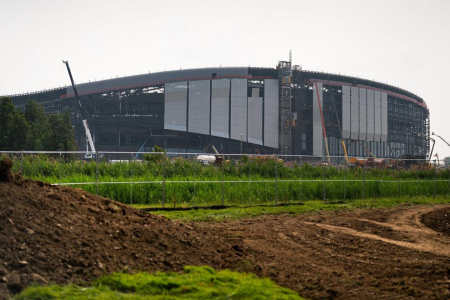
Perforated metal paneling covers the northwest side of the new Buffalo Bills stadium on Thursday.
The panels will help mitigate “wind confusion,” keeping intense breezes from entering the stadium. Joshua Bessex, Buffalo News
As the Bills welcome fans back for the 2025 season – the final one in Highmark Stadium – they’ll get to see more of what Pegula was talking about as finished materials continue to be put up on the nearly fully enclosed exterior of the over $2 billion stadium.
That means not only thousands of perforated metal panels, but also black insulated panels, prefabricated thin brick panels, horizontal-ribbed architectural cornice and glass.
Construction on the exterior will last through the end of the year and possibly into January, but Cravotta said the outside of the building is looking different on an almost daily basis as workers get better and more efficient at putting up the exterior panels.
Fans should notice Saturday afternoon when they come to Orchard Park for the team’s lone home preseason game, 1 p.m. against the New York Giants.
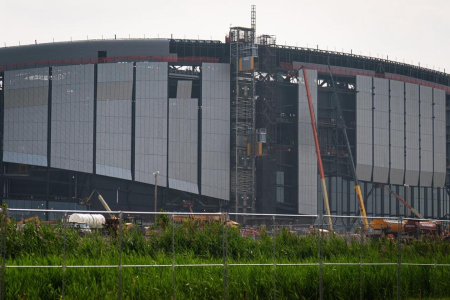
Perforated metal paneling covers the northwest side of the new Buffalo Bills stadium. Joshua Bessex/Buffalo News
“Every game as the season starts and people come back into the stadium, it’s going to look a little different, because it’s looking different daily,” Cravotta said. “That’s how quickly the façade is going up.”
The façade, aesthetically, is being built to mimic classic Buffalo architecture and as a nod to former city stadiums, but maybe more importantly, it will create a barrier to the wind.
The thousands of metal panels being erected serve as a wind screen and are unique in some way, with different size perforations on them to help confuse the wind. A panel on the southeast side will likely be different from one on the northeast side, Cravotta said.

Perforated metal paneling covers the northwest side of the new Buffalo Bills stadium. Joshua Bessex/Buffalo News
On the west side of the building, the aim is to get air to rise up the side, instead of going through, and on the east side – closer to Abbott – there’s more of an open building and larger panel perforations, helping to further weaken the broken wind coming through.
“We know what Western New York has in terms of the wind, snow and cold, and this exterior façade is going to help with wind confusion and making sure every single fan inside has a warm place and a safe space and they’re not being hit as hard with the elements as they are in the current stadium,” Penny Semaia, vice president for stadium relations, said last month during a meeting of the Community Benefits Oversight Committee.
The perforated metal panels are the most advanced technical part of the exterior. There are around 2,200 units and 4,400 panels to install.
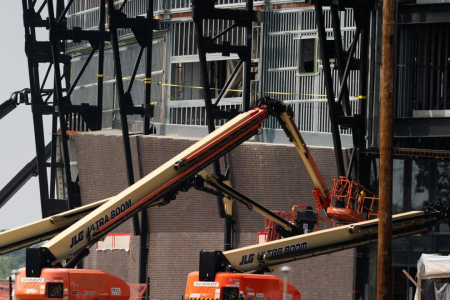
Lifts sit parked next to a brick paneling base at the new Buffalo Bills stadium. Joshua Bessex/Buffalo News
Work to get those up began last month. About 20% of them have been put up so far, most on the west side where new parts of the project get started, Cravotta said.
The new orientation of the building, which has been turned predominantly southeast from the current stadium, will also help in staving off some of the wind howling off Lake Erie.
“We hear about form following function all the time and this is a perfect example of that,” Cravotta said.
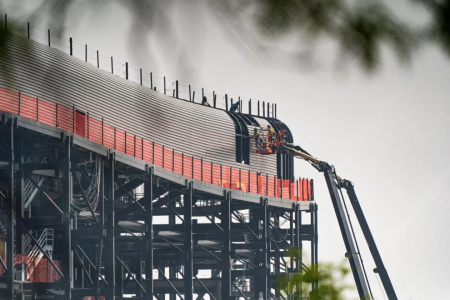
Construction crews work near the roof of the new Buffalo Bills stadium. The horizontal-ribbed
architectural cornice that crowns the stadium will help accentuate the slope and flow of the building. Joshua Bessex, Buffalo News
The exterior also includes prefabricated brick panels, from grade level elevated to around 12 to 20 feet, and much of that installation work is already complete. Large segments and swaths of glass, or glazing, are also being built into the outside of the structure. All are put in after insulation panels help close off the structure.
The horizontal-ribbed architectural cornice, a decorative element that crowns the building, helps create a curved edge and soft flowing effect around the top of the stadium. When completed, it will help accentuate the slope and flow of the building, Cravotta said.
Every other perforated metal panel going up looks indented to create shadows that look like giant windows. Also, tens of thousands of perforations in the panels are cut to form the red charge in the Bills logo, helping make the design unique to Buffalo.
The design of the exterior was inspired by buildings like War Memorial Stadium and Buffalo Memorial Auditorium, both of which had curved facades with vertical openings. Architectural firm Populous, which designed the new stadium, was asked to design the exterior with those buildings in mind, as well as the look of Buffalo City Hall and Kleinhans Music Hall.

Perforated metal paneling covers the northwest side of the new Buffalo Bills stadium. Joshua Bessex/Buffalo News
“This is not just a big, hulking steel structure; it’s a sculpture,” Cravotta said. “We wanted to use that inspiration to harken back to those days in this ultra-modern façade. For fans, that’s going to be hard to see now, but I guarantee when we’re all said and done it will be a subtle, powerful and beautiful expression of the past meeting the future.”
The big push in the stadium construction right now is to enclose all the conditioned spaces, like where marketplaces and restrooms will go, so they can be heated over the winter while work on things like drywall, tiling, flooring and putting up light fixtures are being completed inside. The stadium is completely closed off on the northwest corner of the stadium but not everywhere.
“You can’t wait until the spring to finish that,” Cravotta said. “So, when it’s 15 degrees out, come January, we can still be fully engaged in fit out, graphics, lighting. Things like the locker room will start to happen as well.”
The most complete part of the outside of building is on the northwest part of the stadium, facing the SUNY Erie Community College South campus. The side facing the old stadium across the way on Abbott Road is the least complete part of the project.
“The northwest corner is the starting point as we work our way around the stadium,” Cravotta said.
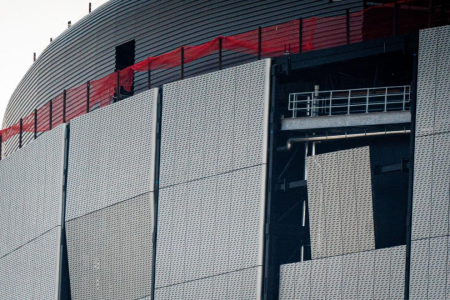
Perforated metal paneling covers the northwest side of the new Buffalo Bills stadium. Joshua Bessex/Buffalo News
Pete Guelli, chief executive officer and senior vice president, said last week that construction is on time to open the stadium for the 2026 season.
“The stadium is starting to develop to a point where it’s looking like the building that we all envisioned,” he said. “We’ll get the keys in July, and we look forward to opening it up.”
Over 1,400 workers are now on-site working throughout the stadium.
“From a schedule perspective, there is nothing that causes us angst,” Cravotta said. “It’s just that the volume of all this is incredible. But we’re feeling good.”
There are so many elements of the project that Cravotta said he never knows what’s coming from day to day. The most important thing right now is prioritizing what needs to get done.
“The scope of it is like nothing else,” said Cravotta, who’s been working seven days a week. “It’s a test in patience, sanity and pride – you name it. But it is an incredible project. I wouldn’t change it for the world.”
